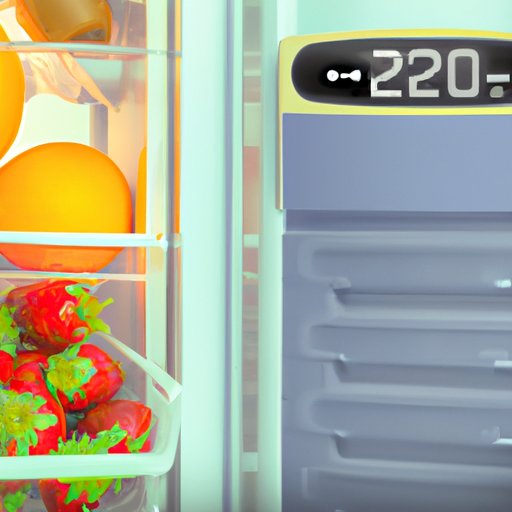Introduction
Having a refrigerator that is set at the correct temperature is essential for maximizing food freshness and safety, as well as conserving energy. But what is the optimal temperature for your fridge? In this article, we explore the benefits of setting your refrigerator to the proper temperature, provide guidance on finding the right temperature range for your fridge, and offer tips for adjusting and maintaining the temperature for maximum efficiency.
A Guide to Finding the Right Refrigerator Temperature
The optimal temperature range for refrigerators is typically between 37 and 40 degrees Fahrenheit. This range allows food to stay fresh while preventing bacteria from growing. Some factors, such as the size and age of the appliance, may affect the ideal temperature for your particular refrigerator.

Factors That Influence Refrigerator Temperature
Several variables can influence the optimal temperature for your refrigerator. For instance, your fridge might need to be adjusted if it’s too big or too old. Older models tend to run hotter than newer ones, so you may need to lower the temperature to get the desired effect. Additionally, the amount of food in the appliance will also have an impact, as a full fridge tends to stay colder than an empty one.

Tips for Setting Your Refrigerator to the Optimal Temperature
Most modern fridges come with an adjustable thermostat, allowing you to easily adjust the temperature. To do this, locate the thermostat control in the back or side of the refrigerator. The exact location and type of thermostat may vary depending on the model. Once you’ve located it, turn the dial until the desired temperature is reached. If you’re unsure what temperature to set it to, consult the owner’s manual for your specific model.
What Is the Best Temperature for My Refrigerator?
The best temperature for your refrigerator will depend on the types of food you’re storing. Generally speaking, dairy products should be stored at around 37-40 degrees Fahrenheit, while meats and poultry should be kept at around 34-38 degrees Fahrenheit. Fruits and vegetables should be stored at around 32-35 degrees Fahrenheit. If you’re storing a variety of foods, you may want to opt for a slightly higher temperature to ensure that all items are properly preserved.
How to Adjust the Temperature of Your Fridge for Maximum Efficiency
To get the most out of your refrigerator, it’s important to check and adjust the temperature regularly. Monitor the temperature inside the fridge using an appliance thermometer, and adjust the thermostat accordingly. You should also consider seasonal changes when adjusting the temperature, as warm weather can cause the appliance to run hotter than usual.

The Benefits of Setting Your Refrigerator at the Proper Temperature
By setting your refrigerator to the optimal temperature, you can maximize food freshness and safety, as well as conserve energy. Keeping the temperature at the recommended range helps prevent foodborne illnesses, reduces spoilage, and keeps food fresher for longer. Additionally, setting the temperature correctly can reduce energy consumption and help you save money on your electricity bill.
Conclusion
Setting your refrigerator to the optimal temperature is essential for preserving food freshness and safety, as well as conserving energy. The ideal temperature range for refrigerators is typically between 37 and 40 degrees Fahrenheit. To find the right temperature for your fridge, consider factors such as the size and age of the appliance, as well as the types of food you’re storing. Additionally, remember to check and adjust the temperature regularly to ensure maximum efficiency. By following these tips, you can maximize the benefits of setting your refrigerator at the proper temperature.


